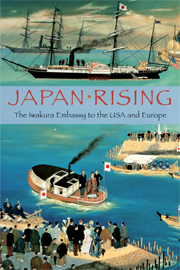Book contents
- Frontmatter
- Contents
- Introduction by Ian Nish
- Note on the Text
- VOLUME I THE UNITED STATES OF AMERICA
- VOLUME II BRITAIN
- 21 A Survey of Britain
- 22 A Survey of London
- 23 A Record of London, 1
- 24 A Record of London, 2
- 25 A Record of London, 3
- 26 A Record of Liverpool, 1
- 27 A Record of Liverpool, 2
- 28 A Record of Manchester, 1
- 29 A Record of Manchester, 2
- 30 A Record of Glasgow
- 31 A Record of Edinburgh
- 32 A Tour of the Highlands
- 33 A Record of Newcastle, 1
- 34 A Record of Newcastle, 2
- 35 A Record of Bradford
- 36 A Record of Sheffield
- 37 A Record of Staffordshire and Warwickshire
- 38 A Record of Birmingham
- 39 A Record of Cheshire
- 40 A Record of London, 4
- VOLUME III CONTINENTAL EUROPE, 1
- VOLUME IV CONTINENTAL EUROPE, 2
- VOLUME V CONTINENTAL EUROPE, 3; AND THE VOYAGE HOME
- Index
33 - A Record of Newcastle, 1
Published online by Cambridge University Press: 04 August 2010
- Frontmatter
- Contents
- Introduction by Ian Nish
- Note on the Text
- VOLUME I THE UNITED STATES OF AMERICA
- VOLUME II BRITAIN
- 21 A Survey of Britain
- 22 A Survey of London
- 23 A Record of London, 1
- 24 A Record of London, 2
- 25 A Record of London, 3
- 26 A Record of Liverpool, 1
- 27 A Record of Liverpool, 2
- 28 A Record of Manchester, 1
- 29 A Record of Manchester, 2
- 30 A Record of Glasgow
- 31 A Record of Edinburgh
- 32 A Tour of the Highlands
- 33 A Record of Newcastle, 1
- 34 A Record of Newcastle, 2
- 35 A Record of Bradford
- 36 A Record of Sheffield
- 37 A Record of Staffordshire and Warwickshire
- 38 A Record of Birmingham
- 39 A Record of Cheshire
- 40 A Record of London, 4
- VOLUME III CONTINENTAL EUROPE, 1
- VOLUME IV CONTINENTAL EUROPE, 2
- VOLUME V CONTINENTAL EUROPE, 3; AND THE VOYAGE HOME
- Index
Summary
October 21st, 1872. Rain.
At ten o'clock in the morning we left our hotel in Edinburgh to travel south to Newcastle. Detonators had been placed on the line to provide a farewell salute as we left the station. Several people from a firm of tweedmakers in Galashiels had come as far as the station at Edinburgh to meet us and travel back with us. It was raining during the journey, so we saw nothing along the way. At half past eleven we arrived at Galashiels Station, where we were met by the deacon [of the Manufacturers' Corporation]. We went straight to the tweed mill by carriage.
Galashiels is sixty miles south of Edinburgh by rail, close to Scotland's south-eastern border. It is a town of something over 10,000 inhabitants, who are very upright in character: we were told that the whole town had only five policemen. When we arrived at the station we found that men and women from all over the town had gathered in the street to see us. The little boys ran up to us, the little girls followed them, and as we moved away our carriages were surrounded, before and behind, by a jostling throng.
The tweed mill, which was very large, belonged to two brothers, Adam and Archibald [Cochrane]. Tweed is woven from wool. Wool is divided into seven basic grades, and it is the finest and softest grade which is used for weaving tweed.
- Type
- Chapter
- Information
- Japan RisingThe Iwakura Embassy to the USA and Europe, pp. 174 - 177Publisher: Cambridge University PressPrint publication year: 2009



